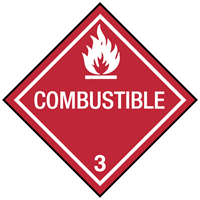
 Print
Print
Chemical Datasheet
1,1-DICHLOROPROPANE |

|
Chemical Identifiers
| CAS Number |
UN/NA Number |
DOT Hazard Label |
USCG CHRIS Code |
- 78-99-9

|
|
|
|
| NIOSH Pocket Guide |
International Chem Safety Card |
|
none
|
|
NFPA 704
data unavailable
General Description
Colorless watery liquid with a sweet odor. Sinks in water. Produces irritating vapor. (USCG, 1999)
Hazards
Reactivity Alerts
Air & Water Reactions
Highly flammable.
Fire Hazard
Special Hazards of Combustion Products: Emits fumes of phosgene (USCG, 1999)
Health Hazard
INHALATION: May cause some central nervous system depression. EYES: May cause some pain and irritation. SKIN: Mild irritation. (USCG, 1999)
Reactivity Profile
Halogenated aliphatic compounds, such as 1,1-DICHLOROPROPANE, are moderately or very reactive. Halogenated organics generally become less reactive as more of their hydrogen atoms are replaced with halogen atoms. Low molecular weight haloalkanes are highly flammable and can react with some metals to form dangerous products. Materials in this group are incompatible with strong oxidizing and reducing agents. Also, they are incompatible with many amines, nitrides, azo/diazo compounds, alkali metals, and epoxides.
Belongs to the Following Reactive Group(s)
- Halogenated Organic Compounds
Potentially Incompatible Absorbents
No information available.
Response Recommendations
Isolation and Evacuation
Excerpt from ERG Guide 128 [Flammable Liquids (Water-Immiscible)]:
IMMEDIATE PRECAUTIONARY MEASURE: Isolate spill or leak area for at least 50 meters (150 feet) in all directions.
LARGE SPILL: Consider initial downwind evacuation for at least 300 meters (1000 feet).
FIRE: If tank, rail tank car or highway tank is involved in a fire, ISOLATE for 800 meters (1/2 mile) in all directions; also, consider initial evacuation for 800 meters (1/2 mile) in all directions. (ERG, 2024)
Firefighting
Fire Extinguishing Agents: Foam, carbon dioxide, dry chemical. (USCG, 1999)
Non-Fire Response
Excerpt from ERG Guide 128 [Flammable Liquids (Water-Immiscible)]:
ELIMINATE all ignition sources (no smoking, flares, sparks or flames) from immediate area. All equipment used when handling the product must be grounded. Do not touch or walk through spilled material. Stop leak if you can do it without risk. Prevent entry into waterways, sewers, basements or confined areas. A vapor-suppressing foam may be used to reduce vapors. Absorb or cover with dry earth, sand or other non-combustible material and transfer to containers. Use clean, non-sparking tools to collect absorbed material.
LARGE SPILL: Dike far ahead of liquid spill for later disposal. Water spray may reduce vapor, but may not prevent ignition in closed spaces. (ERG, 2024)
Protective Clothing
Rubber gloves, self-contained breathing apparatus, coveralls or laboratory coat. (USCG, 1999)
DuPont Tychem® Suit Fabrics
No information available.
First Aid
Call a doctor.
INHALATION: Remove to fresh air. If breathing has stopped, give artificial respiration.
EYES: Flush with running water for 15 minutes.
SKIN: Wash thoroughly with soap and water.
INGESTION: Gastric lavage or emesis and catharsis. (USCG, 1999)
Physical Properties
Flash Point:
70°F
(est.)
(USCG, 1999)
Lower Explosive Limit (LEL):
3.4 %
(est.)
(USCG, 1999)
Upper Explosive Limit (UEL):
14.5 %
(est.)
(USCG, 1999)
Autoignition Temperature:
1035°F
(USCG, 1999)
Melting Point: data unavailable
Vapor Pressure: data unavailable
Vapor Density (Relative to Air): data unavailable
Specific Gravity:
1.1321
at 68°F
(USCG, 1999)
- Denser than water; will sink
Boiling Point:
190.6°F
at 760 mmHg
(USCG, 1999)
Molecular Weight:
112.99
(USCG, 1999)
Water Solubility: data unavailable
Ionization Energy/Potential: data unavailable
IDLH: data unavailable
AEGLs (Acute Exposure Guideline Levels)
No AEGL information available.
ERPGs (Emergency Response Planning Guidelines)
No ERPG information available.
PACs (Protective Action Criteria)
| Chemical |
PAC-1 |
PAC-2 |
PAC-3 |
| Dichloropropane, 1,1- (78-99-9)
|
2.6 ppm |
29 ppm |
170 ppm |
(DOE, 2024)
Regulatory Information
EPA Consolidated List of Lists
| Regulatory Name |
CAS Number/
313 Category Code |
EPCRA 302
EHS TPQ |
EPCRA 304
EHS RQ |
CERCLA RQ |
EPCRA 313
TRI |
RCRA
Code |
CAA 112(r)
RMP TQ |
| 1,1-Dichloropropane |
78-99-9 |
|
|
1000 pounds |
|
|
|
(EPA List of Lists, 2024)
CISA Chemical Facility Anti-Terrorism Standards (CFATS)
No regulatory information available.
OSHA Process Safety Management (PSM) Standard List
No regulatory information available.
Alternate Chemical Names
- 1,1-DICHLOROPROPANE
- PROPANE,1,1-DICHLORO-
- PROPYLIDENE CHLORIDE


 Print
Print
